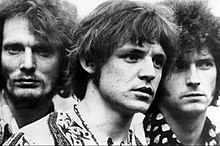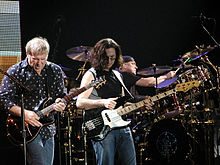Power trio
A power trio is a
Most power trios in hard rock and heavy metal music use the electric guitar player in two roles; during much of the song, they play rhythm guitar, playing the chord progression for the song and performing the song's important riffs, and then switching to a lead guitar role during the guitar solo. While one or more band members typically sing while playing their instruments, power trios in hard rock and heavy metal music generally emphasize instrumental performance and overall sonic impact over vocals and lyrics.[1] One prominent power trio is Motörhead, whose lead vocalist, Lemmy, played bass and sang lead vocals. In the case of power trio ZZ Top, lead vocalist Billy Gibbons plays guitar and sings lead vocals. Although four-piece bands such as the Who or Led Zeppelin may function instrumentally as a power trio, with three instrumentalists and a dedicated lead vocalist, these bands are not usually considered as power trios. Larger rock bands often use one or more additional rhythm sections to fill out the sound with chords and harmony parts.
History
The rise of the power trio in the 1960s was made possible in part by developments in amplifier technology that greatly enhanced the volume of the electric guitar and bass. Particularly, the popularization of the electric bass guitar defined the bottom end and filled in the gaps. Since the amplified bass could also now be louder, the rest of the band could also play at higher volumes while still being able to hear the bass. This allowed a three-person band to have the same sonic impact as a large band but left far more room for improvisation and creativity, unencumbered by the need for detailed arrangements. As with the organ trio, a 1960s-era soul jazz group centered on the amplified Hammond organ, a three-piece group could fill a large bar or club with a big sound for a much lower price than a large rock and roll band. A power trio, at least in its blues rock incarnation, is also generally held to have developed out of Chicago-style blues bands such as Muddy Waters' trio.

In addition to technological improvements, another impetus for the rise of the power trio was the virtuosity of guitarists such as

Well-known 1970s-era power trios include the Canadian progressive rock groups Rush and Triumph,[7] the American band ZZ Top,[8] the English heavy metal band Motörhead, and the Robin Trower Band. Emerson, Lake & Palmer (as well as its offshoot Emerson, Lake & Powell) is usually considered a power trio[9][10] as Keith Emerson fulfilled the rhythm and lead playing on the keyboards that would usually fall on the guitarist, while bassist (and occasional guitarist) Greg Lake on vocals. In 1968, the power trio Manal was formed in Argentina, and were the first group that composed blues music in Spanish.[11][12]

After the 1970s, the phrase "power trio" was applied to the
See also
- List of power trios
- Organ trio: a three-person soul jazz or jam band group centred on the Hammond organ
References
- ISBN 978-0787299699.
- ISBN 0-7043-7066-2.
- ^ Gilliland, John (1969). "Show 53 – String Man" (audio). Pop Chronicles. University of North Texas Libraries.
- ^ Olsen, Andrew. "An Interview with Don Brewer of Grand Funk Railroad". duluthreader.com. Retrieved 12 June 2013.
- ^ Cariappa, Shiv (January 8, 1997). "Interview With Gerry McAvoy". Christian Science Monitor. Archived from the original on 23 October 2014. Retrieved 22 June 2013.
In the late 1960s, two music groups, Taste and Cream, blazed trails as definitive examples of rock's power-trios.
- ^ "Billboard". Billboard.
- ^ UPI (December 11, 1974). "New Rock Music Trio Coming on Strong". The Dispatch. Retrieved 1 June 2013.
- ^ Javier Martínez sube al escenario del teatro Colón con lo mejor del blues
- ^ Las 10 bandas más revolucionarias del Rock Nacional
- ^ Clark, Dick (July 15, 1983). "The Police: An Arresting Power Trio". Milwaukee Record-Journal. Retrieved 2 June 2013.
